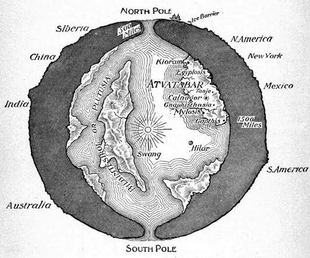
Back أرض مجوفة Arabic Teoria intraterrestre Catalan زەویی ھڵۆڵ CKB Dutozemě Czech Theorie der hohlen Erde German Κοίλη Γη Greek Creencia en la Tierra hueca Spanish نظریه زمین توخالی Persian Ontto Maa Finnish Théories de la Terre creuse French

| Part of a series on the |
| Paranormal |
|---|
The Hollow Earth is a concept proposing that the planet Earth is entirely hollow or contains a substantial interior space. Notably suggested by Edmond Halley in the late 17th century, the notion was disproven, first tentatively by Pierre Bouguer in 1740, then definitively by Charles Hutton in his Schiehallion experiment around 1774.
It was still occasionally defended through the mid-19th century, notably by John Cleves Symmes Jr. and J. N. Reynolds, but by this time it was part of popular pseudoscience and no longer a scientifically viable hypothesis.
The concept of a hollow Earth still recurs in folklore and as a premise for subterranean fiction, a subgenre of adventure fiction. Hollow Earth also recurs in conspiracy theories such as the underground kingdom of Agartha and the Cryptoterrestrial hypothesis and is often said to be inhabited by mythological figures or political leaders.
© MMXXIII Rich X Search. We shall prevail. All rights reserved. Rich X Search